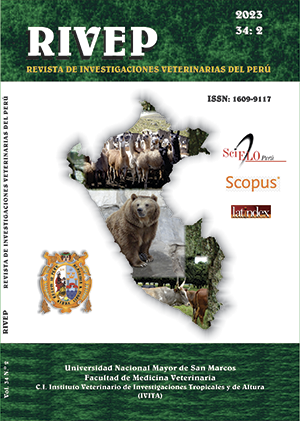Carcass growth and properties in Colombian Criollo Hair Sheep (OPC) and F1 Dorper x OPC
Características de crecimiento y de la canal en ovinos criollos y F1 Dorper
DOI:
https://doi.org/10.15381/rivep.v34i2.23786Keywords:
lambs, heterosis, productive performance, OPC, meat productionAbstract
The aim of this study was to evaluate the productive performance and carcass characteristics in Creole hair sheep (OPC) and F1 Dorper x OPC crosses in Córdoba, Colombia. Twenty-five lambs (14 F1 Dorper x OPC and 11 OPC) were used (9 males and 16 females), managed in a semi-stall system and supplemented with a mixture of cottonseed and ground corn. The lambs were slaughtered at approximately 6.5 months of age. The effect of sex, type of parturition (single, twins) and breed type was determined. Within the productive performance, only a significant difference was found in the pre-weaning weight gain (p<0.05) due to sex and breed type. Carcass characteristics were significant for the breed type effect, rump width/leg length ratio, leg and rump girth, rump, hip and leg width, loin eye area, and width and depth of the back. It is concluded that the F1 animals presented better performance than the OPC for growth and carcass characteristics.
Downloads
Downloads
Published
Issue
Section
License
Copyright (c) 2023 Oscar Vergara-Garay, Moris Bustamante-Yánez, Osmyth Díaz Castelar, Eliana Neiva Rojas, Camilo Camargo Pitalua, Jorge Noriega Marquez

This work is licensed under a Creative Commons Attribution 4.0 International License.
AUTHORS RETAIN THEIR RIGHTS:
a. Authors retain their trade mark rights and patent, and also on any process or procedure described in the article.
b. Authors retain their right to share, copy, distribute, perform and publicly communicate their article (eg, to place their article in an institutional repository or publish it in a book), with an acknowledgment of its initial publication in the Revista de Investigaciones Veterinarias del Perú (RIVEP).
c. Authors retain theirs right to make a subsequent publication of their work, to use the article or any part thereof (eg a compilation of his papers, lecture notes, thesis, or a book), always indicating the source of publication (the originator of the work, journal, volume, number and date).



